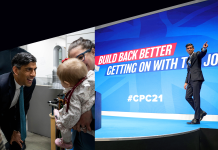Voting continues in the Indian general elections, with Modi likely to come out on top. Patrick Ward, a writer for Project-India.com reports from India on the largest elections that the world has ever seen.

Everyone has an opinion on the general elections currently underway in India. From the wealthy inhabitants of the luxurious, gleaming apartment buildings of South Mumbai, to the women who make a living sifting through piles of rubbish in the slums of Gujarat, politics is a subject you can discuss with nearly anyone.
The stakes are high, and everyone knows that the result of the nearly five-week long poll will have a huge impact on the direction the country is set to take for the next five years. It’s probably not an exaggeration to say that this is the most important election since Independence. The country has seen dramatic economic growth over the past decade and a half, although this has recently stalled.
Over 800 million people are set to vote, around 150 million of whom will be doing so for the first time. This is the biggest election in world history, and you can’t go long without being hit by the wall-to-wall TV coverage, mass billboard campaigns and megaphone-topped trucks working their way through busy city streets and poorly maintained village roads proclaiming which party symbol you should place your mark next to.
And at the centre of all this are two parties – or, rather, two men. For Congress, which has held power for a total of 49 of the 67 years since Independence, their hope is Rahul Gandhi, son of party chair Sonia Gandhi. He is a career politician by birth, being the latest of the Nehru-Gandhi dynasty to attempt to win over the country. His grandmother and father were both prime ministers, and both were assassinated. But Congress is in deep trouble. Of the 543 seats up for grabs, they are predicted to take under a hundred. This would be a historic defeat for the party, but perhaps unsurprising.

Congress corruption has been widespread and well documented, with lucrative government contracts going to political allies at knockdown prices. The average Congress candidate has assets worth around double that of any other party, and the party’s insistence on standing the latest wealthy Nehru-Gandhi family member is staring to grate. Coupled with that, prices are rocketing, with vegetables increasing in cost by 157% between 2004 and 2013. Staples such as onions went up an eye-watering 521%, and cabbage increased by 714%.
Some 17% of India’s urban population lives in slums, often without electricity or clean water. During the monsoon season, it is not unusual for people to have to abandon their dwellings to seek refuge elsewhere, and face the prospect of malaria and other water-borne diseases, often with a significant distance to travel for the nearest hospital.
It is against this backdrop that the Hindu chauvinist BJP has found its champion – the man who all polls suggest will become the next prime minister with a landslide vote. Narendra Modi is everywhere you look. His smiling, bearded face looks down on you from billboards across the country. Orange BJP flags adorn shops, cars and houses. His main claim is to have increased growth in the state of Gujarat, where he is chief minister. New roads have been built as he sells off land at peppercorn prices, and there have been limited attempts to improve infrastructure, such as building low cost housing.

It’s certainly true that Modi has received cross-class, cross-caste support across the country, from people desperate for change from the arrogant, stagnant politicians of Congress who seem to be far more interested in filling their own pockets than improving life for the 1.2bn+ population. Modi, with the help of huge campaign contributions from India and abroad, has truly set the election agenda. Congress is perpetually on the back foot. Congress-controlled Maharashtra, for example, has a similar growth rate to Gujarat, but they were too arrogant to make that argument.
But the most dangerous thing about Modi isn’t his hyper-neoliberal economic model, it’s his far-right Hindu nationalism. The Gujarat riots of 2002 are a shadow Modi finds it difficult to escape. Here, over 700 Muslims were brutally murdered over three days in Gujarat, as they were blamed for a fire on a train full of Hindus. Adults and children were hacked to death with swords, burned to death and drowned in the rampage. It came after chief minister Modi sought to put the blame on Muslims for the train disaster. To this day, Modi refuses to apologise. He has also blocked attempts to rebuild the Mosques torched in the riots, and Gujarat has also attempted to prevent scholarships for minorities in the state.
Modi is trying to get Muslim votes in the election, but the mask slips relatively frequently among his followers. BJP leader Giriraj Singh said in April that Modi’s critics should “go to Pakistan”. When I asked Bharat Dangar, the president of the BJP in Baroda, Gujarat (one of the places Modi is standing for parliament), why a Muslim slum had not seen development typical of Hindu slums, I was told it was partly because the inhabitants were not as clean as in other areas, and that the problems often come from Bangladeshi (dog-whistle: Muslim) immigrants (of whom I saw none on my travels there – why would people immigrate from Bangladesh to a small slum in Gujarat?).

Some Muslims are backing Modi, but it is a very small number. Most are fearful of what will happen next.
Modi has also spoken about his desire to stand up to Pakistan, after years of relative peace between the countries as all dialogue avoids the thorny issue of Kashmir. That always riled the right wing, and Modi is likely to change policy in this area.
Some unions are also worried. G Sanjeeva Reddy, president of the Congress-supporting Indian National Trade Union Congress, has said that Modi will jail trade union leaders if he is elected. It’s not uncommon for Modi to be labelled “fascist” by his opponents.
It should also be noted that Modi comes from the extreme-right Hindu-nationalist RSS, a group linked strongly to the BJP. A flavour of things Modi says to keep them sweet could be seen last week in West Bengal, when he said Bangladeshi immigrants should be ready to leave India after 16 May. He had said just weeks before that Hindus from Bangladesh should be welcomed in India, so he was clearly talking about expelling Muslims. The RSS lapped it up.
In this context, people have a choice between a corrupt Congress party that has taken the electorate for granted for far too long, but which does speak about the benefits of multiculturalism, and the supposed economic achievements of Modi and the BJP, if they can justify relegating “the past” to the past.
There is a third major force in the election – that of the anti-corruption Aam Aadmi (Common Man) Party, led by Arvind Kejriwal. This grew out of the India Against Corruption movement, and spectacularly rose to take power in Delhi last year as a minority government. The coalition lasted just 49 days before the AAP withdrew after its Congress partners refused to endorse an anti-corruption bill that was centrepiece to the AAP campaign there. The party resigned from power. While this was probably the most principled thing to do, Kejriwal himself has said that the party should have consulted the voters more before doing it, and ever since this has been a big stick with which to beat the party who are now being presented as not ready for power.
The AAP’s left-reformist programme is still supported by a huge number of voters, and in Mumbai it is common to see streets of hawkers and taxi drivers wearing the trademark white cap of the party. The support also spreads into the professional classes. But their support has been squeezed by the terror many people see in the growth of Modi, and are more likely to vote for the corrupt Congress than risk splitting the vote and supporting AAP.
The AAP has faced other problems. In the affluent Mumbai South constituency – perhaps the richest in India – the AAP candidate was Meera Sanyal, a former RBS executive whose website feaures Ayn Rand quotes. There is a certain tug-of-war between genuine aam aadmis and “respectable” candidates. And despite the party’s talk of preventing candidates with criminal cases against them standing for election, 26% of its own candidates in the first five stages of the election fit this bill, with a further 10% facing “serious” charges, which would include murder, robbery and rape.
It’s never easy to predict how the elections here will go, especially when you consider the roles of the over-1,000 regional parties taking part who may thrash together some sort of coalition at the last minute. Congress, in desperation, is currently talking about forming a Third Front government with the ideologically similar Communist Party of India and others in a grand secular coalition. But even that may fall short. Congress may just want to sit this one out and recover, and other parties may simply not want to touch Congress with a barge pole.
It looks as though there will be a Modi premiership when the results are released later in May. If this is the case, it may be that the BJP is tempered by whatever coalition partners they have in the Lok Sabha. But the BJP and others in its National Democratic Alliance coalition have largely been reduced to Modi’s supporting team – it is the man himself who featured on all the posters and all the news reports. For example, in Mumbai the Shiv Sena party – a far-right Hindu nationalist group that wants preferential treatment for Marathis over North Indians, Muslims and others, has billboards that essentially proclaim, “Vote Shiv Sena, get Modi”.
The West is rapidly attempting to build bridges with Modi as they prepare for his victory. Until recently, he was not even allowed to travel to the US due to his alleged role in the Gujarat riots. Now he will be seen as a shining light in the international push for neoliberalism, and rehabilitated accordingly.




















http://socialistworker.org/2014/05/05/fear-clouds-the-indian-elections
Is it correct to describe the programme of Aam Aadmi (Common Man) Party as ‘left reformist’? As the article correctly points out they run on an anti-corruption programme but otherwise are not in the least hostile to capitalism. They are reformers not reformists in the proper sense. It is also highly likely that as a result of internal cotradictions they will not be the second big story of the election with Modis ascent to power the top story.
If I may I would like to point to the real story of the elections which is the decay of the reformist workers parties principally the CPI and the CPI (M) although the smaller bodies which are parasitical on alliances with the big two are also rotten through and through. Given that union federations are directly linked to political parties in India this also means that the federations linked to the CP’s are also more or less useless from the point of view of the needs of those they represent.
That this decay can lead idealistic urban youth to take a lead from the Maoists of the CPI (Maoist) and abandon the working class is another secondary lesson of the decay of the reformist parties. But we should also look to the ability of the working class to generate new organs of resistance to capitalist exploitation. For example the New Trade Union Initiative http://ntui.org.in/ springs to mind.